Interview: Rocksled Suspension's Wild New Linkage Fork
Much like gearboxes, linkage forks are one of those ideas that keep cropping up decade after decade but so far have never quite managed to go mainstream. To their proponents, the list of advantages is impressive.
For a start, the major source of friction in a telescopic fork (the sliding stanchions) is eliminated, which promises greatly improved sensitivity. And much like with rear suspension linkages, there's the potential to alter the leverage ratio - that's the number of millimeters the axle moves for every millimeter the shock moves. In a telescopic fork, that ratio is fixed at 1:1, but with a linkage, the leverage can vary with travel, creating the potential for progressive spring and damping rates that are almost universally accepted as advantageous on the back of the bike. It's also possible to use the brake's torque to resist brake dive so the fork stays higher in its travel under braking, at least compared to a telescopic fork.
The bottom line is that linkage forks offer much more design freedom. So while there have been many linkage forks in the past (both in the MTB and motorcycle world), in many ways they are as different from one another as they are from telescopic forks.
With that in mind, I got in touch with Ashley Kalym, who has been designing his own take on the linkage fork in his spare time under the name of Rocksled Suspension. I've been following Rocksled on Instagram for years now and have been in contact occasionally to discuss his design in the past. Some of you may remember Mike Levy covered the first version of Ashley's "fork" three years ago, which was single-sided and carbon fiber with a single pivot link. Since then Ashley's changed to a two-sided design with a 15 mm axle for broader compatibility. He's also changed to a steel structure with a floating brake mount. I decided to get the full story on how and why his project has been evolving.
 What motivated you to embark on building a linkage fork?
What motivated you to embark on building a linkage fork?
I had taught myself CAD for non-bike-related projects, and as I had been riding for a long time I thought I'd have a go at tackling a purely mechanical problem (as I saw it). I was aware of the differences between front and rear suspension, and asked myself why a frame/structure arrangement hadn't been done for the front suspension as it is done for the rear. The obvious choice for me was to use an off-the-shelf rear shock as the damper, as this would simplify the problem for me and give a huge range of possible sizes to choose from, making the task easier.
 What performance characteristics were you hoping to achieve or prioritize?
What performance characteristics were you hoping to achieve or prioritize?
I was hoping to do three things: First was to remove stiction and binding as much as possible. The second was to be able to use an off-the-shelf shock/damper, and be able to easily swap them for increased rider choice. The third was to use the linkage arrangement to manipulate the axle path and introduce a leverage curve.
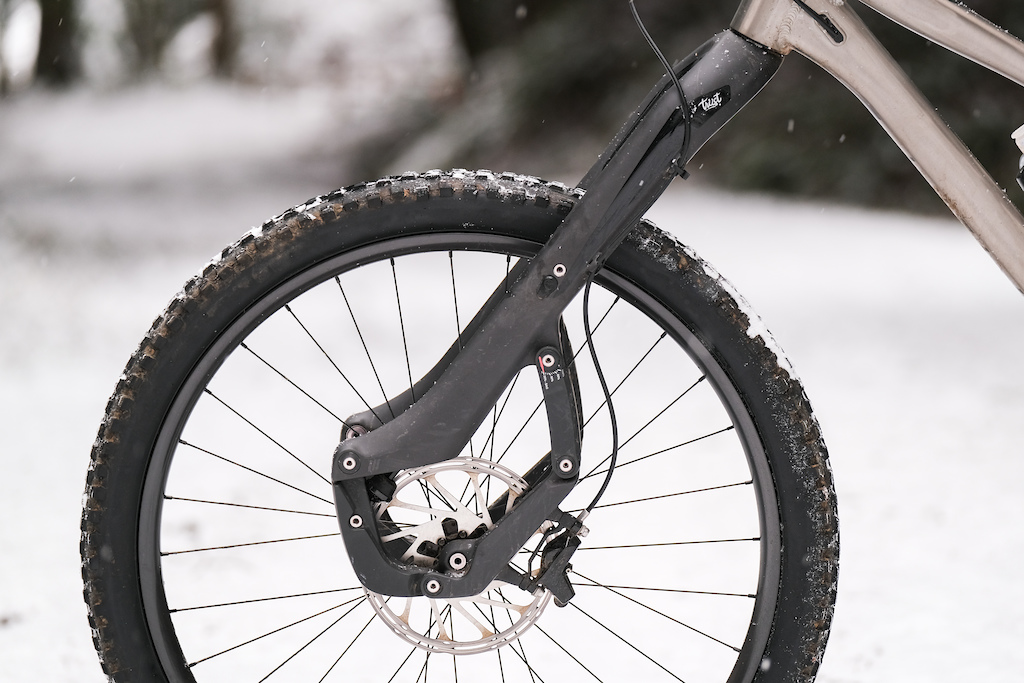
 Why did you decide on a leading link design, as opposed to a trailing link like Trust uses?
Why did you decide on a leading link design, as opposed to a trailing link like Trust uses?
The reason was simply to do with space and packaging. I knew I had to get an off-the-shelf shock in there somehow, and having the fork legs more vertical (when compared with the head tube) leaves more space for everything. The wheel path differs between the two (a forward-facing arc instead of a backward-facing arc), but the starting point and end point of the wheel can be fairly similar.
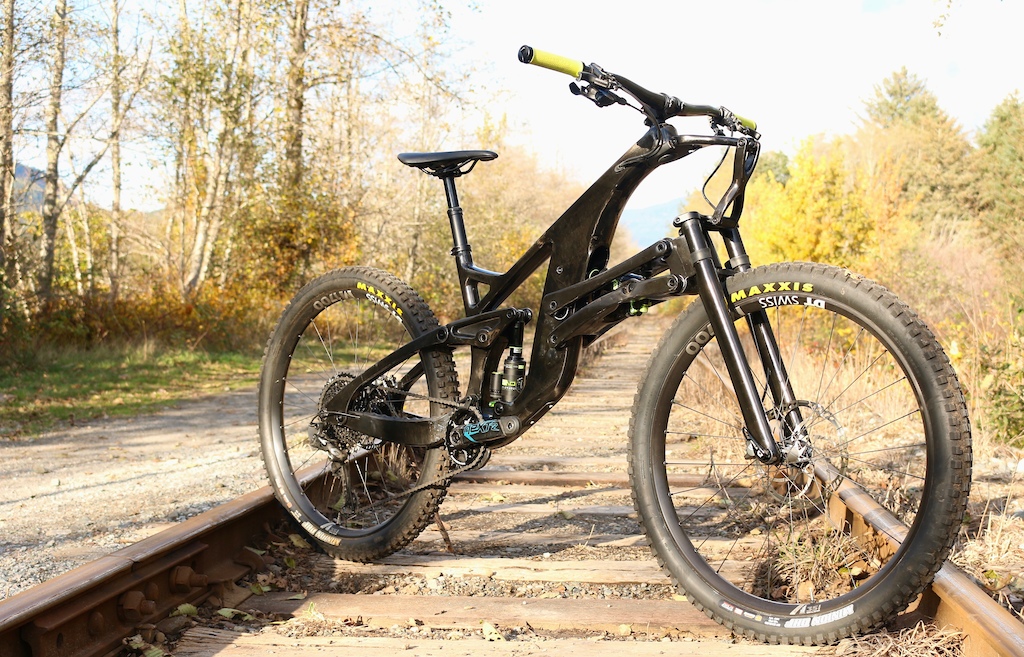
 Did you look into the linkage forks on the market (for example, those from Trust, Structure, and Motion) for inspiration? If so, how does your design compare to those?
Did you look into the linkage forks on the market (for example, those from Trust, Structure, and Motion) for inspiration? If so, how does your design compare to those?
I didn't really look at them for inspiration, but I was aware of them. I definitely couldn't figure out why other approaches had gone with their own damper for example, as there are so many off-the-shelf ones that to me it was a no-brainer to use existing technology. Structure's approach isn't a stand-alone fork, but having read Mike Levy's review of the bike and how insanely active the "fork" was, it was confirmation that it is possible to do something like this. Obviously, the Trust and Motion forks are sleeker and more compact footprint-wise, and they have gone into production and I am still at the prototyping stage, but referring back to my goal with the fork; what frame manufacturer designs and supplies their own shocks? Very few, if any. They worry about the tubes, linkages, bearings, etc., and leave the damping to someone else.

 There's so much design freedom with a linkage fork - so many possibilities. How did you decide on the combination of axle path, leverage curve, and anti-dive that you have?
There's so much design freedom with a linkage fork - so many possibilities. How did you decide on the combination of axle path, leverage curve, and anti-dive that you have?
I wanted to keep everything as standard as possible in terms of axle to crown, travel, offset (starting at least), etc., so my design isn't really extreme. The offset starts at 44mm and reduces by 50% when the fork bottoms out. Axle path is dictated by the curve, which in turn is dictated by the distance between the pivot and the axle, so I had to make this long enough to give a gradual curve, but not too short that the arc was very tight.
The leverage curve was the best I could get using the simplest suspension layout, so it is progressive, but not massively so. Using an air shock would add progressivity if needed, as would a progressive spring, so if it doesn't feel progressive enough for some people, then this can be taken care of.
The anti-dive is an interesting one. The first prototype (single-sided, carbon fibre leg, featured in an article on Pinkbike a while ago) had no control of the braking forces, as the brake caliper was bolted directly onto the link. The anti-dive force was very strong and I didn't get on with it at all. So the second version (the fork I am currently riding) has a fully floated brake to get rid of anti-dive force altogether (apart from the compression associated with weight transfer). No one has a problem with the axle path and braking behavior of telescopic forks, so I decided it wouldn't make sense to tinker with these too much. Overall I think linkage forks really shine when it comes to activeness, shock choice (if using off-the-shelf models), and being able to design in features that are present on rear suspension (leverage curve, axle path, etc.).
 Tell me about the choice of shock and shock tune.
Tell me about the choice of shock and shock tune.
The shock on the second version (that I am riding currently) is a Marzocchi Bomber C1 in 230mm x 65mm metric. For the third version, I'll move to a 210mm x 50mm for packaging reasons. I experimented with a few different sizes, but getting everything to fit in a package that is small enough is very difficult, and required a lot of trial and error. But as the design stands now, any shock type should fit, even air shocks with larger bodies, and shocks with piggyback reservoirs. Shock tune isn't something I have experimented with yet, as I have been focused on tweaking the design and getting things feeling good, but I'm sure I'm missing a trick by not tuning the shock properly. In addition, this is a side project that I try and do when I am not working or looking after family (three kids), and so things like shock tuning do come last I'm afraid! I imagine that a high-end shock with a proper tune for my riding style and ability would take the fork to another level, so I really should find some time to send it off and get it tuned!
 Stiffness is a concern with many linkage forks. How did you address that?
Stiffness is a concern with many linkage forks. How did you address that?
The fork legs on the second version (the one that I am riding now) are steel and feel very robust. The linkages sit on 20mm axles and run on 20x32mm bearings, with a 20mm axle for the wheel with plenty of overlap. It feels hugely stiff to me, but then again I am not a heavy rider, nor am I a hugely fast or competent rider either. I certainly haven't chased light weight as a factor in the design, and in the 18 months plus of riding version 2 I've never thought that it needed to be stiffer. I think it can be a bit misleading though, as the sheer activeness of the fork makes it feel like you have a flat tire sometimes, even when it's not, so could this also lead to a noodly feeling? I'm not sure. I do observe that telescopic forks have a join at the steerer tube/crown, another join at the stanchion/crown junction, and another join between the stanchions and the lowers. I think reducing the number of joins can only increase the feeling of stiffness, so I guess it depends on the linkage fork design that is pursued.
 How does it ride?
How does it ride?
It rides as I thought it would to be honest; because there is so little stiction the fork moves into its travel with very little effort, even when it's run with less sag than normal. It looks strange from a riding viewpoint, but as the offset is more or less normal it doesn't feel vastly different steering-wise. The small bump sensitivity and the fact that I'm running a coil shock mean it's incredibly active over any bumps, and it's a bit jarring to go back to a telescopic fork, as it feels like they have a threshold that needs to be overcome to get them moving.
Braking wise it feels normal as well, as version 2 has a fully floating brake, so the braking behavior doesn't affect the suspension directly as version 1 did. It certainly is heavier than a telescopic fork, especially with a coil shock and a normal spring, but version 3 will be lighter. Steering feels very good with the reducing offset, but could I tell the difference between it and a telescopic fork? I'm not sure. I think a very good rider could though, and on paper, the reduction in the offset figure should increase steering stability.
 I have to ask - how much does it weigh?
I have to ask - how much does it weigh?
I'm not sure how much version 2 weighs, but it's more than a telescopic fork for sure.
 What's next?
What's next?
Next is to finalise the design for version 3, and get that made. Then ride it to check everything is as it should be, then send it off for testing. If that's successful and it doesn't break after lots of abuse, then I'll look to do a limited run of 5 or 10 forks and see how it's received. If I sell any then I'll be in touch with the riders to see what problems they might have. As long as that goes OK then sort any small issues, then look to try and get it into the market. Obviously, it will be a niche product, but I think there might be enough people out there that are interested in linkage forks to make it viable.
If you've seen any more innovative homemade MTB projects, let us know in the comments so we can bring them into the limelight.
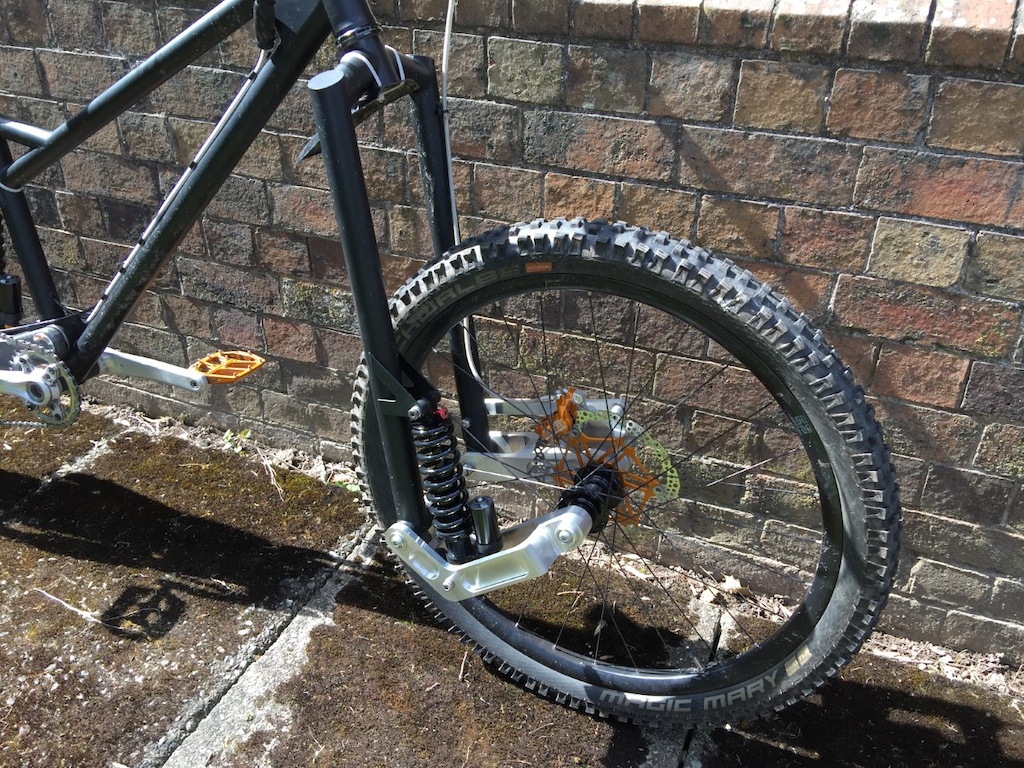
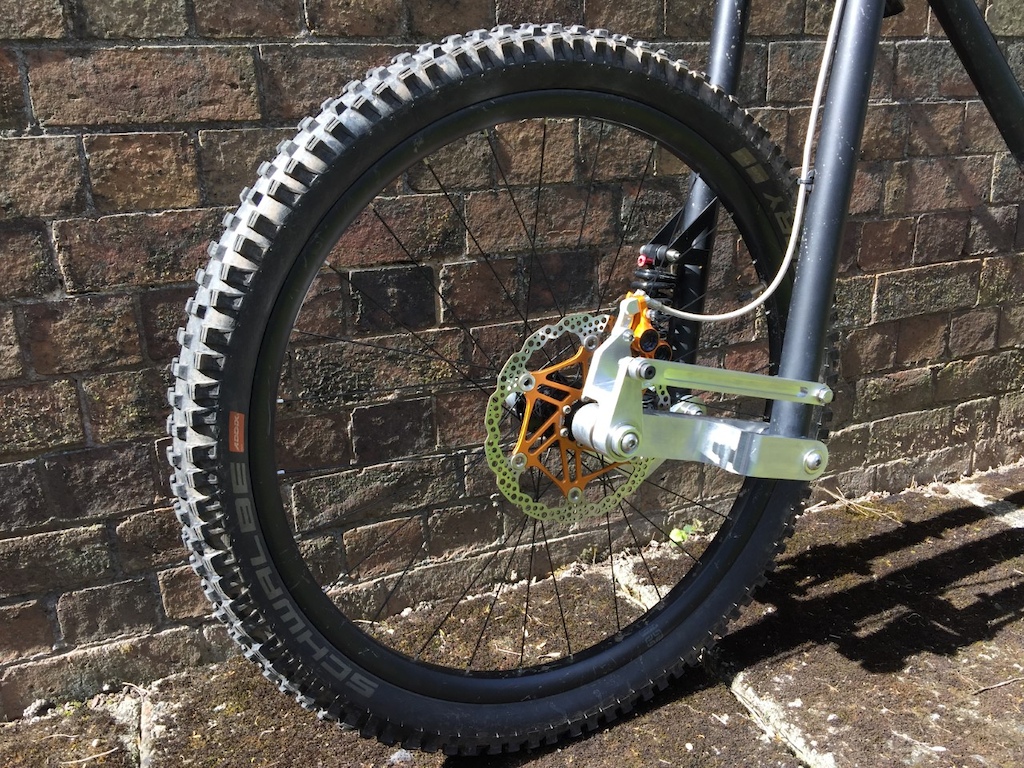
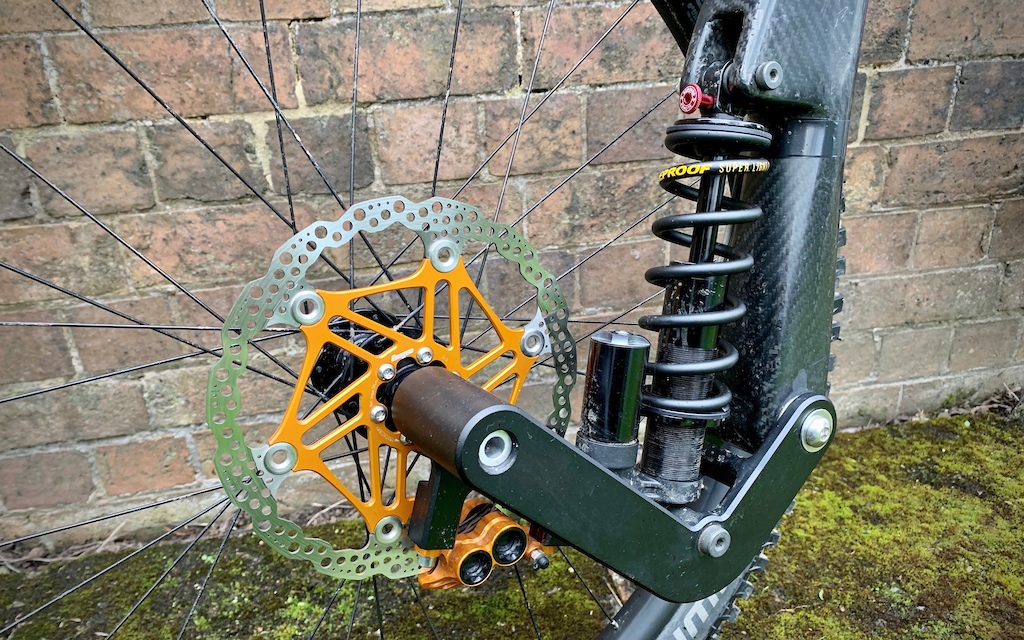

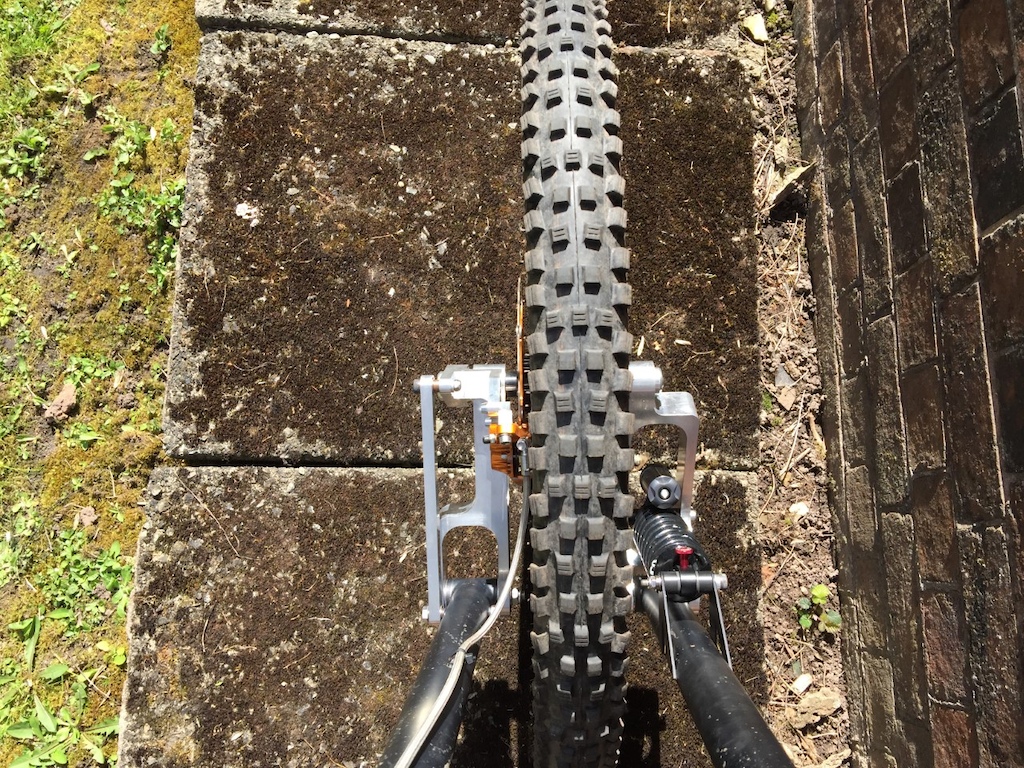



You could easily be into the travel and hit the bottom of the link or the Fork leg
Is there a video showing the clearance between it and the ground at full compress?
It's nonsense though, you can't ride a bike as fast as Jackson Goldstone or Jessie Malamed and they absolutely can go faster without building this shit. To me its as unnecicary as cable routed headsets.
1. Low pivot, as you described, and like the Trust products. It's easier to create a stiff chassis, but the short links make it difficult to create optimal kinematics, as Trust discovered. Additional links can be added to tune the kinematic properties, though that defeats the simplicity of the low pivot platform.
2. High pivot, such as Motion Ride. More difficult packaging and structural properties, but more potential for good kinematics.
3. Chassis integrated, dual-axis, used by Structure. Much more freedom in the kinematics. The lower fork no longer has to move on the same axis as the stem, so the dynamic handling properties can be independently tuned. For example, the head-tube angle can get slacker as it compresses, increasing stability when highly loaded, rather than getting steeper and reducing stability.
If you take the approach that the best thing for front wheels is a normal telescopic fork, and then engineer away from that. You'll get a much better product than taking the best thing for back wheels, and engineering that to work on the front end. Which is what all current linkage forks do.
The bearing pivots of a linkage system already move so much more smoothly than the linear bushings of a telescoping fork that it's unnecessary to chase even greater compliance gains via a rearward axle path. Instead, there's more performance to be gained by "investing" some of that extra smoothness in optimized dynamic geometry.
Another concern is the use of both sliders for travel and a linkage for axle path tuning. If such a design already requires a linkage, it's more efficient to use the linkage for both travel and kinematics, allowing for the elimination of the redundant telescoping apparatus.
I can smash rocks and roots uphill like an MX bike, and drop into uphill faces, like an MX bike, which is where I established all of my two-wheeled skills.
Those Trust forks catch way too much crap from people who never rode one!
I swear I thought of it before I heard of Buttercups. 3 days before..
I’ve had my Message apart- those carbon bits are so pretty.. And so plentiful! That fork looks just oozes “cost no object”.
I saw one for $350 on Pinkbike a while back. Sad, but maybe it’s an idea whose time has finally come.
Maybe this single pivot clunker showing up on PB is only the beginning of the beginning of a new crop of linkage forks. Which would give my fork instant OG street cred..
Damn. I don't know. More, though. Definitely more.
It’s obviously not been a focal point. This is admittedly a hobby project and he still needs to send a shock for a tune.
If it gains traction and turns into a biz I could imagine one of the shock cos creating custom solution. But lots of people will like the idea of tinkering.
As it sits, it sure looks like significantly more unsprung mass.
Hopefully he doesn’t toil away for months just to reinvent something.
Hopefully this is the moment of the resurgence of linkage forks!
The Bimota is hugely expensive, you'd have to be a rich, track focused rider to want one. The Beemer is also expensive, but all their bikes are. In either case you are paying a premium price largely based on novelty. Neither of these suspension systems have ever been successful in competition, and that's with big time engineering departments driving the programs.
For everything that's "wrong " with telescopic forks, no matter what kind of motorcycle racing you watch, that's what they use. Well, at least the guys that win...
And BMW has a linkage/telescopic combo fork.
Levy loved the structure but obviously the complexity is a problem. Most reviewers agreed the trust had lots of benefits but ultimately had too many compromises to be successful. The potential is there, it remains to be seen if anybody can strike the right balance.
I think the long travel one was 27.5 only. So sad.
And agree lefty is mild compared to this. I like at least that you just bolt a shock into it. Cool and crazy.
For your two main arguments :
"It did not reachass acceptance" - you know they used to be mainstream, right ? Also, mainstream brands such as BMW tried it recently
"Just too expensive in comparison with the simple sliding legs design" - several applications in the Moto world that are not constrained by cost, such as Moto GP, MX, etc never really got into it, why ?
Yes, it obviously is, it's indisputable. The stiction associated with the telescopic design is inherently difficult to overcome, as well as its lack of rigidity. Of course you can have fun with a telescopic fork and it will fulfill its role, but the buttery responsiveness of a linkage fork, as well as the rigidity it can offer, is unmatched by a telescopic fork of any stanchion size. It's just a different riding experience.
This (and all linkage forks) is engineering for the sake of fiddling at the margins. Interesting concepts, but never going to go further than that.
seems like braking would prevent the fork from working versus resisting diving, no? at the very least, break traction while braking...
When not braking, the fork will sag to a point where the shock force and weight on it balance one another.
When braking, the centre of mass of the system (rider + bike) shifts forward. The suspension compresses to a new position that is a balance of the forces acting on it (weight and torque, if we ignore it sticking due to friction). The forces are now balanced, so any bump force will disturb the balance and cause compression, regardless of whether the fork compressed, extended, or neither when it reached its braking balance point.
A linkage fork can choose the balance point under braking load by tuning how much brake torque acts upon the suspension. Many linkage fork designers have chosen 100% anti-dive, meaning the brake torque equals the weight shift, resulting in no additional compression due to braking. I chose a different (and adjustable) amount of anti-dive for the Structure that reduced brake dive, while still feeling somewhat familiar to a telescoping fork. In both cases, though, the forced end up balanced and bump forces are equally free to compress the suspension; the difference is how much extra sag is induced to reach that balance.
It's one step better to measure it at sag (flat ground, under rider weight), but is that really the situation that matters most?
Maybe head-tube angle matters most at full pitch (100% front compression, 0% rear). Even if we compared head-tube angles at this extreme situation, do we use flat ground? If we use angled ground, what angle best represents the conditions when we are most concerned about head-tube angles?
Regardless of how we measure it, I can tell you this much: The kinematics package I created for a front linkage involves a head-tube angle that is slightly steeper than average when measured static, and becomes much slacker than average at full compression, when compared to telescoping forks under the same conditions. I'm sure it's not the absolute perfect design - give me as much R&D time and money as has been used for traditional suspension and I'll give you a slightly better design! - but I believe it's already better than telescoping designs.
Having said that, I also spoke to a guy with a 1200gs adventure that he took on track and he said that the telelever front end meant he could outbrake any of the sports bikes, so wtf, this whole comment feels like a waste now...
www.ebay.ca/itm/123872652211
There is a lot more R&D money going into motocross bikes, follow the MX trends because they do what works.
We need more inverted fork options in the mtb world. That is the future!
First, I've heard the chassis rigidity is pretty good, so they're off to a good start.
There are so many variables within the kinematics that have little prior art to draw upon. The brake anti-dive is high, and it's unclear at this point in front linkage R&D to say whether it's too high or would be ideal once people get used to it, but it would certainly take some adaptation. Axle path isn't alarming - certainly better than that of another, better-known front linkage fork. Wheel rate is difficult to determine because I don't know the properties of the spring - neat design, though!
The shock is a concern, as there's a poor record of alternative shocks matching the performance of more established brands. It could be great, for all I know, just saying they've given themselves a huge challenge that few others have met, on top of all the other challenges of a front linkage design - not to mention market acceptance of things that look different!
If you've seen any more innovative homemade MTB projects, let us know in the comments so we can bring them into the limelight.
Innovate don’t bellyache
Good lord
"Not sure...more than a telescopic fork for sure"
That's code for "This thing probably weighs 4x what a regualr fork does."
$500 seems to be going price for the dodo bird of forks.
Needs some work!
Twitter
Bike cranks?
The Rocksled design may require more material to reach the appropriate level of stiffness, but it certainly can reach such a level.
That may be a separate issue, though, as I interpreted dstroud70's question to pertain to steering geometry, like head-tube angle and trail. These things also aren't necessarily different from a traditional fork.
I’m gonna use your point to make another- the very best linkage fork on the planet may never find a home on it.
I don’t like telescopic Mtn bike forks short of full DH forks. My Trust Message has addressed most of those issues, but in doing so it has ostracized those familiar with telescopic forks. When it’s in it’s element, most reviewers will call it weird at best.
Yes, we can tell.